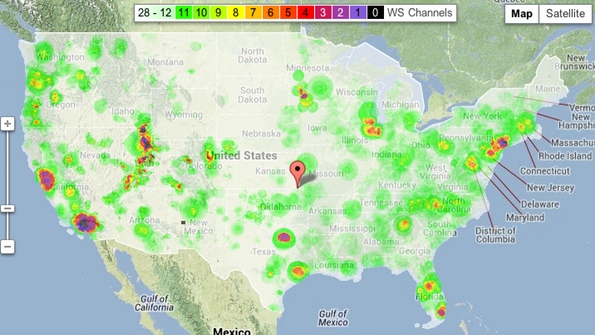Next Wave: Google’s TVWS Helps Whitespace Broadband Advance

White space could be the next big thing. It’s a spectrum that is underused in TV, but could be a savior for high-speed Internet service. The FCC voted to open up this spectrum of waves to unlicensed wireless devices way back in 2008, but little has happened with it since. Until now, that is. Momentum from Google and others just might pave the way for rural areas to get high-speed Internet, something they might not ever get otherwise.
Low-frequency TV white-space bands have some unique characteristics, they propagate a lot farther than Wi-Fi, and are much better at passing through hills and areas of dense foliage. Broadband passing through this spectrum runs about 16Mb/s at the base station, but actual users on the network would clock in at around 4Mb/s. Today’s mega-speed broadband can make this sound like small potatoes, but its actually very fast in rural areas that are resigned to dial-up because the houses are so far apart that it is not worth it for companies to build broadband networks in.
Google has stepped in and developed a TV white-space database (TVWS), showing which white-space channels work in which areas. That is a lot to sort through, and TVWS is intending to make it easier. Registered white-space devices will be able to use the database to automatically determine which frequencies that the devices can transmit on. The wireless devices send encrypted location information to the database and get back the results on which slice of the spectrum will work best.
Curious about your area? Have a look and browse the spectrum in your own region:
https://www.google.org/spectrum/whitespace/channel/index.html
While Google has been working to launch high-speed fiber service in new areas, it’s also keeping an eye on the other end of the spectrum, focusing on rural areas that can’t be financially developed for broadband, but can utilize white space to wedge in faster-than-dial-up broadband rates to customers who would not have the chance at high speed otherwise .
TVWS and the white-space initiative are finally gaining momentum after the FCC approval many years ago, but it’s still an early and growing technology. But the good news is it's starting to be implemented, and is a great step forward to ensuring that one day everyone will have access to broadband, no matter where they live.
The professional video industry's #1 source for news, trends and product and tech information. Sign up below.
